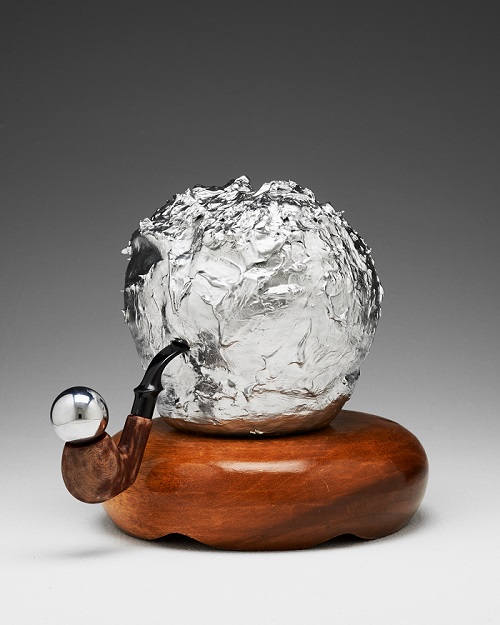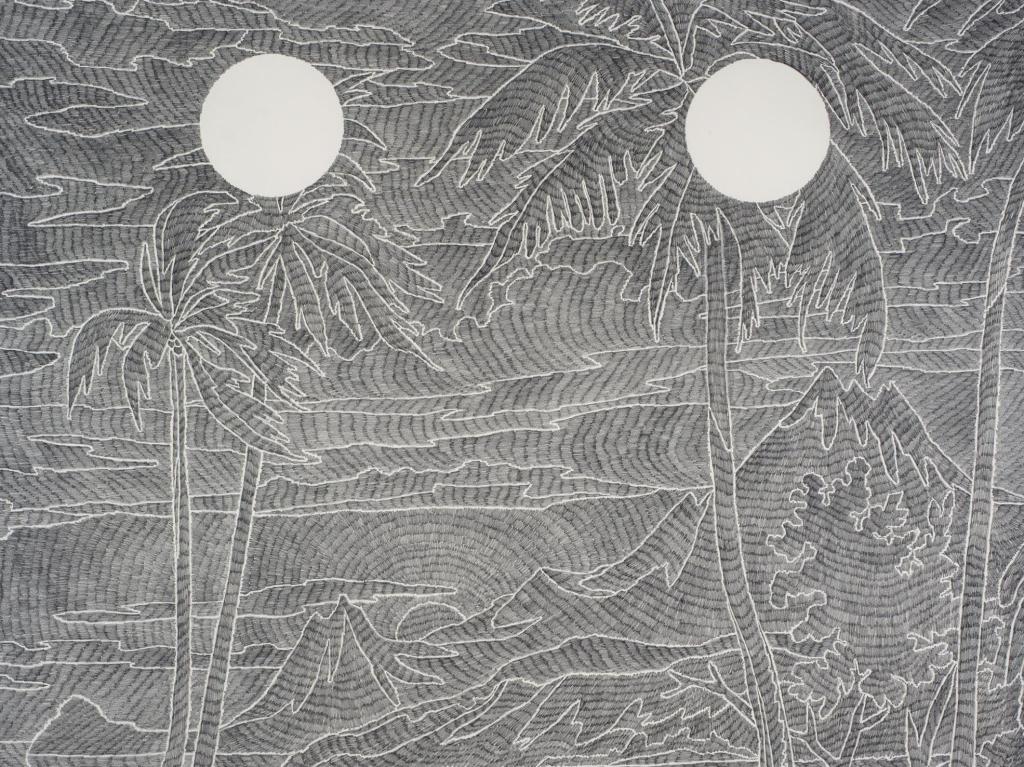Laith McGregor, This Old Night 2017 (detail), pencil on paper 211.5 x 17 cm; courtesy the artist
Queensland artist Laith McGregor is the winner of the 2018 Bendigo Art Gallery’s Paul Guest Prize for contemporary drawing with This Old Island, a large (198x153cm) graphite on paper work. His current exhibition at the Tweed Regional Gallery (a collaboration with Caloundra Regional Gallery) features three earlier pieces from the same series, with a sampling of other work indicative of his evolving practice, including ceramics and a digital video installation.
Known widely for his painstakingly detailed, large-scale biro and pencil portraits, the artist’s fascination with the phenomenon of pareidolia is ubiquitous in this exhibition titled Borrowed Time. Robert Mann’s new collection of essays ‘On Borrowed Time’ was published last February concurrent with this collection’s first showing in Caloundra. The coincidence throws into contrast the title’s traditional existential idiom with McGregor’s pun on his creative preoccupation with appropriation and collaboration, and his exhaustive process.
The contract for our viewing of the entire exhibition is set with the installation Untitled (Don Patterson) (2012), a small unframed painting hangs askew on a large wall. Found in an ‘op shop’, it appears to be a tone study in oil signed ‘Don Patterson’. Moving closer you become aware of two peep-holes cut into the eyes. Visible through the eyeholes is another work in the next room: a single channel digital video, Clay (2014), which is a self-portrait with an anonymous pair of male hands invasively manipulating the artist’s face.
The peep-holes – or voids – recur consciously in the majority of the exhibited pieces, either as negative spaces in the heavily rendered work on paper This Old Night (2017) or purposefully drawn in on the ‘make-over’ series or the sequence of five lithographs portraits.
In Sleepy Landscape (2017) and Tired Landscape (2017) the voids are covered by conical rattan hats. From a distance the large emblematic image of a face is obvious, reminding us of the hand of the artist and, more so, pit-stops to remind us of the industry of the work’s creation.

Laith McGregor, St Petersburg; courtesy the artist
These three works from 2017 are supplemented with a large scale site specific, but ephemeral, wall drawing Past (2018). For these, and his Guest Prize entry, McGregor relied on generic images of South Pacific Island life ‘borrowed’ from Paint by Number kits (developed by Max Klein in 1950). The ‘colour’ is replaced by laboriously applied directional pencil strokes, the actual outlines left as negative space.
The explanatory notes by curator Hamish Sawyer – in a neat catalogue designed by Michael Phillips – tells us that it takes ‘approximately three months to finish a large-scale drawing … each dense band … can be read as a marker or unit of time in completing the work.’
But, in the pre-opening gallery walk-through, McGregor also revealed that he’s often assisted in the process. He collaborated with a number of Murwillumbah students to complete Past in just a few days.
The labour and materials consumption is further reinforced with One Year (2014) a display of twelve month’s worth of pencil shavings in a framed acrylic box.
These works are mesmerising and tantalising as you adjust focus and proximity; they are admirable, too, in terms of the artist’s dexterity and temerity.
Works on paper like Hobo (1900-2016) and Clouds (1940-2016) originate as portraits by unknown 20th century artists, collected and worked over by McGregor. Sawyer uses the word ‘intervene’ to describe McGregor’s additions of doodled stream of conscious text and cartoon-type portraits (many copied or referenced) to fill the negative space.
This intervention manipulates the emphasis of the original composition with linear rhythm and pattern. Again, these works have an intricate close-up experience and a distant viewing option, where an emblematic face emerges.
Similarly, the lithographs – including Animal (2013) and Ohne Titel [German: Untitled] (2013) – are based on a ‘neutral’ self-portrait produced by McGregor (as the recipient of the Collie Print Trust Printmaking Fellowship at the Australian Print Workshop) but here defaced in a naughty school-boy cartoonish graffiti – doodles, text, exaggerated moustaches and noses, buck teeth, spectacles – and seemingly executed with a range of contributors.
These two series are not as profound, as say Barbara Kruger’s overlaid photographs, nor as deliberately subversive in their wit – despite McGregor’s often cynically pithy titles – as Joe Orton and Kenneth Halliwell’s library book defacements.
The scatter of works in clay – made from discarded, waste clay – are clumsy and naive, perhaps deliberately so. Their scale and significance further reduced by a curiously awkwardly display on low rostra and adjacent to the enlarged blueprint Past. Each constructed piece has thumb print impressions that hint at a bust and variously placed on what looks like a sarong in Byblos (2014), or a ream of white paper as with the work Athens (2014).
Overall the exhibition Borrowed Time provides provocative pieces and invite much speculation on McGregor’s thesis about the placement of the artist in the industry of creativity, but the relatively small sample on display – in gallery space that is far too generous – doesn’t provided enough work to sufficiently join the dots.
What we can appreciate, however, is a significant conceptual artist in transition, exercising his evolving practice – with a daft sense of humour – and recognising, perhaps like Robert Mann, that he has little time to waste.
Rating: 2½ stars: ★★☆
Laith McGregor: Borrowed Time
Tweed Regional Gallery, Murwillumbah NSW
Curator: Hamish Sawyer, Caloundra Regional Gallery
5 October – 2 December, 2018





